清华大学:《编译原理》课程教学资源(PPT课件)RUN-Time Organization

RUN-Time Organization Compiler phase- Before writing a code generator,we must decide how to marshal the resources of the target machine (instructions,storage,and system software)in order to implement the source language.This is called run-time organization
RUN-Time Organization Compiler phase— Before writing a code generator, we must decide how to marshal the resources of the target machine (instructions, storage, and system software) in order to implement the source language. This is called run-time organization
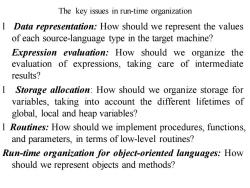
The key issues in run-time organization 1 Data representation:How should we represent the values of each source-language type in the target machine? Expression evaluation:How should we organize the evaluation of expressions,taking care of intermediate results? 1 Storage allocation:How should we organize storage for variables,taking into account the different lifetimes of global,local and heap variables? 1 Routines:How should we implement procedures,functions, and parameters,in terms of low-level routines? Run-time organization for object-oriented languages:How should we represent objects and methods?
The key issues in run-time organization l Data representation: How should we represent the values of each source-language type in the target machine? Expression evaluation: How should we organize the evaluation of expressions, taking care of intermediate results? l Storage allocation: How should we organize storage for variables, taking into account the different lifetimes of global, local and heap variables? l Routines: How should we implement procedures, functions, and parameters, in terms of low-level routines? Run-time organization for object-oriented languages: How should we represent objects and methods?
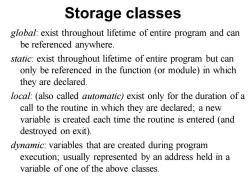
Storage classes global:exist throughout lifetime of entire program and can be referenced anywhere. static:exist throughout lifetime of entire program but can only be referenced in the function (or module)in which they are declared. local:(also called automatic)exist only for the duration of a call to the routine in which they are declared;a new variable is created each time the routine is entered (and destroyed on exit). dynamic:variables that are created during program execution;usually represented by an address held in a variable of one of the above classes
Storage classes global: exist throughout lifetime of entire program and can be referenced anywhere. static: exist throughout lifetime of entire program but can only be referenced in the function (or module) in which they are declared. local: (also called automatic) exist only for the duration of a call to the routine in which they are declared; a new variable is created each time the routine is entered (and destroyed on exit). dynamic: variables that are created during program execution; usually represented by an address held in a variable of one of the above classes

Both global and static variables have a single instance that persists throughout life of program and the usual implementation for these is a collection of memory locations in the global/static data segment of the executable.These locations are fixed at the end of the compilation process. Local variables only come into existence on entry to a routine and persist until its exit.To handle these we use a runtime stack that holds the values of locals.The area of memory used to hold all the locals of a routine is called the stack frame(active record).The stack frame for the routine currently executing will be on top of the stack. Dynamic allocation of further storage during the run of a program is done by calling library functions (e.g.,malloc()).This storage is obtained from memory in a different segment than the program code, global/static,or stack.Such memory is called the heap
Both global and static variables have a single instance that persists throughout life of program and the usual implementation for these is a collection of memory locations in the global/static data segment of the executable. These locations are fixed at the end of the compilation process. Local variables only come into existence on entry to a routine and persist until its exit. To handle these we use a runtime stack that holds the values of locals. The area of memory used to hold all the locals of a routine is called the stack frame(active record). The stack frame for the routine currently executing will be on top of the stack. Dynamic allocation of further storage during the run of a program is done by calling library functions (e.g., malloc()). This storage is obtained from memory in a different segment than the program code, global/static, or stack. Such memory is called the heap
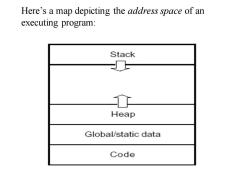
Here's a map depicting the address space of an executing program: Stack Heap Global/static data Code
Here’s a map depicting the address space of an executing program:

In a stack frame (activation record)we hold the following information: 1)frame pointer:pointer value of the previous stack frame so we can reset the top of stack when we exit this function.This is also sometimes called the dynamic link 2)static link:in languages (like Pascal but not C or Decaf)that allownested function declarations,a function may be able to access the variables of the function(s)within which it is declared.In the static link,we hold the pointer value of the stack frame in which the current function was declared. 3)return address:point in the code to which we return at the end of execution of the current function. 4)values of arguments passed to the function and locals and temporaries used in the function
In a stack frame (activation record) we hold the following information: 1) frame pointer: pointer value of the previous stack frame so we can reset the top of stack when we exit this function. This is also sometimes called the dynamic link. 2) static link: in languages (like Pascal but not C or Decaf) that allow nested function declarations, a function may be able to access the variables of the function(s) within which it is declared. In the static link, we hold the pointer value of the stack frame in which the current function was declared. 3) return address: point in the code to which we return at the end of execution of the current function. 4) values of arguments passed to the function and locals and temporaries used in the function
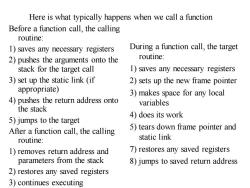
Here is what typically happens when we call a function Before a function call,the calling routine: 1)saves any necessary registers During a function call,the target 2)pushes the arguments onto the routine: stack for the target call 1)saves any necessary registers 3)set up the static link (if 2)sets up the new frame pointer appropriate) 3)makes space for any local 4)pushes the return address onto variables the stack 4)does its work 5)jumps to the target After a function call,the calling 5)tears down frame pointer and routine: static link 1)removes return address and 7)restores any saved registers parameters from the stack 8)jumps to saved return address 2)restores any saved registers 3)continues executing
Here is what typically happens when we call a function Before a function call, the calling routine: 1) saves any necessary registers 2) pushes the arguments onto the stack for the target call 3) set up the static link (if appropriate) 4) pushes the return address onto the stack 5) jumps to the target After a function call, the calling routine: 1) removes return address and parameters from the stack 2) restores any saved registers 3) continues executing During a function call, the target routine: 1) saves any necessary registers 2) sets up the new frame pointer 3) makes space for any local variables 4) does its work 5) tears down frame pointer and static link 7) restores any saved registers 8) jumps to saved return address
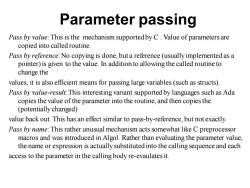
Parameter passing Pass by value:This is the mechanism supportedby C.Value of parameters are copied into called routine. Pass by reference:No copying is done,but a reference(usually implemented as a pointer)is given to the value.In addition to allowing the called routine to change the values,it is also efficient means for passing large variables(such as structs). Pass by value-result:This interesting variant supported by languages such as Ada copies the value of the parameter into the routine,and then copies the (potentially changed) value back out.This has an effect similar to pass-by-reference,but not exactly. Pass by name:This rather unusual mechanism acts somewhat like C preprocessor macros and was introduced in Algol.Rather than evaluating the parameter value, the name or expression is actually substituted into the calling sequence and each access to the parameter in the calling body re-evaulates it
Parameter passing Pass by value: This is the mechanism supported by C . Value of parameters are copied into called routine. Pass by reference: No copying is done, but a reference (usually implemented as a pointer) is given to the value. In addition to allowing the called routine to change the values, it is also efficient means for passing large variables (such as structs). Pass by value-result: This interesting variant supported by languages such as Ada copies the value of the parameter into the routine, and then copies the (potentially changed) value back out. This has an effect similar to pass-by-reference, but not exactly. Pass by name: This rather unusual mechanism acts somewhat like C preprocessor macros and was introduced in Algol. Rather than evaluating the parameter value, the name or expression is actually substituted into the calling sequence and each access to the parameter in the calling body re-evaulates it
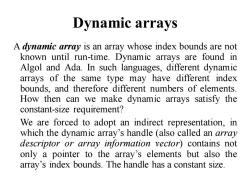
Dynamic arrays A dynamic array is an array whose index bounds are not known until run-time.Dynamic arrays are found in Algol and Ada.In such languages,different dynamic arrays of the same type may have different index bounds,and therefore different numbers of elements. How then can we make dynamic arrays satisfy the constant-size requirement? We are forced to adopt an indirect representation,in which the dynamic array's handle (also called an array descriptor or array information vector)contains not only a pointer to the array's elements but also the array's index bounds.The handle has a constant size
Dynamic arrays A dynamic array is an array whose index bounds are not known until run-time. Dynamic arrays are found in Algol and Ada. In such languages, different dynamic arrays of the same type may have different index bounds, and therefore different numbers of elements. How then can we make dynamic arrays satisfy the constant-size requirement? We are forced to adopt an indirect representation, in which the dynamic array’s handle (also called an array descriptor or array information vector) contains not only a pointer to the array’s elements but also the array’s index bounds. The handle has a constant size
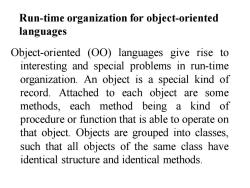
Run-time organization for object-oriented languages Object-oriented (OO)languages give rise to interesting and special problems in run-time organization.An object is a special kind of record.Attached to each object are some methods,each method being a kind of procedure or function that is able to operate on that object.Objects are grouped into classes, such that all objects of the same class have identical structure and identical methods
Run-time organization for object-oriented languages Object-oriented (OO) languages give rise to interesting and special problems in run-time organization. An object is a special kind of record. Attached to each object are some methods, each method being a kind of procedure or function that is able to operate on that object. Objects are grouped into classes, such that all objects of the same class have identical structure and identical methods
按次数下载不扣除下载券;
注册用户24小时内重复下载只扣除一次;
顺序:VIP每日次数-->可用次数-->下载券;
- 清华大学:《编译原理》课程教学资源(PPT课件)第十二章 代码生成.ppt
- 清华大学:《编译原理》课程教学资源(PPT课件)第十一章 代码优化.ppt
- 清华大学:《编译原理》课程教学资源(PPT课件)第八章 语法制导翻译和中间代码生成.ppt
- 清华大学:《编译原理》课程教学资源(PPT课件)第五章 LL(1)文法及其分析程序.ppt
- 清华大学:《编译原理》课程教学资源(PPT课件)第二章 PL/0编译程序.ppt
- 清华大学:《编译原理》课程教学资源(PPT课件)第九章 符号表.ppt
- 清华大学:《编译原理》课程教学资源(PPT课件)第三章 词法分析.ppt
- 清华大学:《编译原理》课程教学资源(PPT课件)第一章 概述.ppt
- 清华大学:《编译原理》课程教学资源(PPT课件)第六章 LR分析程序及其自动构造.ppt
- 兰州大学:《编译原理》课程电子(PPT教学课件)第一讲 引论 CompilerPrinciples.ppt
- 西北工业大学:《编译原理》课程教学资源(PPT课件)编译原理课程设计指南.ppt
- 计算机科学丛书:《编译原理》书籍PDF电子版(美)Alfred V.Aho Monica s.Lam Ravi Sethi Jeffrey D.Ullman,机械工业出版社,中文第二版,共12章.pdf
- 《编译原理》课程教学资源(书籍文献)Lex和Yacc从入门到精通.pdf
- 中国科学技术大学:《编译原理》课程教学资源(教程)编译原理实验教程(草稿).pdf
- 石河子大学:《编译原理》课程教学资源(PPT课件)第十章 运行时空间组织.ppt
- 石河子大学:《编译原理》课程教学资源(PPT课件)第十一章 代码优化.ppt
- 石河子大学:《编译原理》课程教学资源(PPT课件)第六、七章 语法分析——自下而上分析.ppt
- 石河子大学:《编译原理》课程教学资源(PPT课件)第八章 语法制导翻译和中间代码生成.ppt
- 石河子大学:《编译原理》课程教学资源(PPT课件)第九章 符号表.ppt
- 石河子大学:《编译原理》课程教学资源(PPT课件)第四章 词法分析.ppt
- 清华大学:《编译原理》课程教学资源(PPT课件)第十章 目标程序运行时的组织.ppt
- 清华大学:《编译原理》课程教学资源(PPT课件)第四章 文法和语言.ppt
- 西北工业大学:《编译原理》课程教学资源(PPT课件)编译原理知识点回顾(主讲:林奕).ppt
- 西北工业大学:《编译原理》课程教学资源(PPT课件)语法分析程序的自动生成工具YACC简介.ppt
- 西北工业大学:《编译原理》课程教学资源(PPT课件)第1章 绪论(主讲:康慕宁).ppt
- 西北工业大学:《编译原理》课程教学资源(PPT课件)第2章 前后文无关文法和语言(2.1-2.2).ppt
- 西北工业大学:《编译原理》课程教学资源(PPT课件)第2章 前后文无关文法和语言(2.3-2.5).ppt
- 西北工业大学:《编译原理》课程教学资源(PPT课件)第3章 词法分析及词法分析程序(3.1)设计扫描器时应考虑的问题.ppt
- 西北工业大学:《编译原理》课程教学资源(PPT课件)第3章 词法分析及词法分析程序(3.2)正规文法和状态转换图.ppt
- 西北工业大学:《编译原理》课程教学资源(PPT课件)第3章 词法分析及词法分析程序(3.3.1-3.3.4).ppt
- 西北工业大学:《编译原理》课程教学资源(PPT课件)第3章 词法分析及词法分析程序(3.3.5)具有ε动作的NFA的确定化.ppt
- 西北工业大学:《编译原理》课程教学资源(PPT课件)第3章 词法分析及词法分析程序(3.4)正规表达式与正规集.ppt
- 西北工业大学:《编译原理》课程教学资源(PPT课件)第4章 语法分析和语法分析程序(4.1)自顶向下的语法分析.ppt
- 西北工业大学:《编译原理》课程教学资源(PPT课件)第4章 语法分析和语法分析程序(4.2-4.2.3).ppt
- 西北工业大学:《编译原理》课程教学资源(PPT课件)第4章 语法分析和语法分析程序(4.2.4)LR分析法.ppt
- 西北工业大学:《编译原理》课程教学资源(PPT课件)第5章 语法制导翻译及中间代码生成(5.1-5.2).ppt
- 西北工业大学:《编译原理》课程教学资源(PPT课件)第5章 语法制导翻译及中间代码生成(5.3)常见中间语言简介.ppt
- 西北工业大学:《编译原理》课程教学资源(PPT课件)第5章 语法制导翻译及中间代码生成(5.4-5.5).ppt
- 西北工业大学:《编译原理》课程教学资源(PPT课件)第5章 语法制导翻译及中间代码生成(5.6)程序流控制语句的翻译.ppt
- 西北工业大学:《编译原理》课程教学资源(PPT课件)第5章 语法制导翻译及中间代码生成(5.7)含数组元素的算术表达式及赋值语句的翻译.ppt
